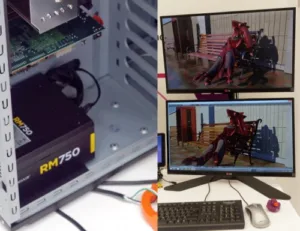Imagination Technologies had a meeting room in the South Hall as it has had for several years. It had lots to talk about.
The firm bought ray tracing company, Caustic Technology (Display Monitor Vol 17 Issue 48), in 2010 and last year the company told us that it was working on the use of ray-tracing (which is very computationally intensive) only in the areas of an image where it makes a real difference. We remarked that this looked like a good use case for “foveated rendering” i.e. using gaze recognition to see where the user is looking and devoting the highest level of resources to that region of the image. We heard that the firm is working with eye-tracking technology on this approach. Imagination believes that the ray tracing technology could get to market in a mobile “super console” in a couple of years.
At the show, Imagination was showing its latest rendering using its ray tracing on its GR6500 GPU with a mixture of raster- and ray trace-based rendering. The company was showing how good its rendering it is using as little as 10% of the power used compared to an Nvidia SLI system. However, the image quality of the ray traced version was much more realistic than the image rendered using raster rendering.
The Imagination ray tracer (above) was running on the single PCI board, while the raster render was from Nvidia on the SLI system. Click on image for higher resolution. Image:Meko Ltd
We looked at some work that Imagination is doing along with MIPS licensee, Renesas, to develop processor systems for automotive applications. Renesas has developed systems with up to six CPUs. The system takes advantage of the virtualisation and containerisation of applications. This means that individual applications can be run independently and with security.
Although Imagination’s tradition is in GPUs, in recent years it has been working on video and image processing and demonstrations at the show included an H.265 codec running on a PowerVR processor and supporting UltraHD output on a Huawei Mate8. An example of the value of its video processing was that the firm has its technology in the AppleTV, the Amazon Fire TV and the Google Nexus player, which all have the company’s video processing and GPU.
The firm believes that in the near future there will be “cameras in everything” and it was showing a demonstration of its chips being used to identify “regions of interest”, such as faces using its image processing technology. Imagination expects this kind of feature to be more and more important as we go forward.

